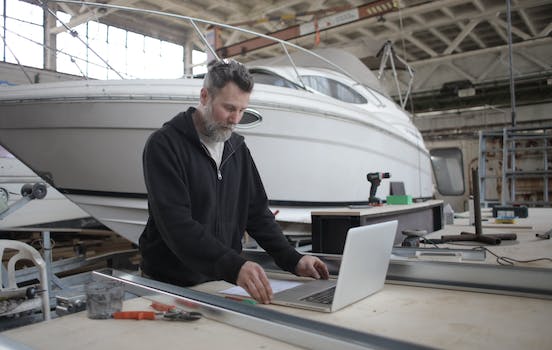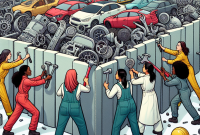
Exploring the Impact of 3D Printing on the Automotive Industry
-
Table of Contents
- Introduction
- How 3D Printing is Revolutionizing Automotive Design and Manufacturing
- Examining the Benefits of 3D Printing for Automotive Parts and Components
- Exploring the Potential of 3D Printing for Customizing Automotive Parts
- Analyzing the Impact of 3D Printing on Automotive Supply Chains
- Investigating the Challenges of 3D Printing for Automotive Manufacturers
- Q&A
- Conclusion
“Unlock the Possibilities of 3D Printing: Revolutionizing the Automotive Industry!”
Introduction
The automotive industry is one of the most important industries in the world, and it is constantly evolving. In recent years, 3D printing has become an increasingly popular technology, and it has had a significant impact on the automotive industry. 3D printing has allowed for the production of complex parts and components that were previously impossible to manufacture. It has also enabled the production of lighter and more efficient vehicles, as well as the development of new materials and technologies. In this article, we will explore the impact of 3D printing on the automotive industry, and how it is changing the way cars are designed, manufactured, and used.
How 3D Printing is Revolutionizing Automotive Design and Manufacturing
The automotive industry is undergoing a revolution, and 3D printing is at the forefront of this transformation. 3D printing is revolutionizing automotive design and manufacturing, allowing for faster, more efficient production of parts and components.
3D printing has enabled automakers to create complex parts and components that would have been impossible to produce using traditional manufacturing methods. This technology has allowed for the production of parts with intricate details and shapes that would have been too costly or time-consuming to produce using traditional methods. 3D printing also allows for the production of parts with complex geometries, such as curved surfaces and hollow cavities, which are difficult to produce using traditional methods.
3D printing has also enabled automakers to reduce the cost of production. By using 3D printing, automakers can produce parts and components with fewer steps and less material, resulting in lower production costs. Additionally, 3D printing allows for the production of parts with complex geometries, which can reduce the number of parts needed for a given product. This can result in significant cost savings for automakers.
3D printing has also enabled automakers to reduce the time it takes to produce parts and components. By using 3D printing, automakers can produce parts and components in a fraction of the time it would take to produce them using traditional methods. This can result in faster production times and shorter lead times, allowing automakers to get their products to market faster.
Finally, 3D printing has enabled automakers to create lighter, stronger parts and components. By using 3D printing, automakers can produce parts with complex geometries that are lighter and stronger than those produced using traditional methods. This can result in lighter, more fuel-efficient vehicles, as well as improved safety and performance.
The automotive industry is undergoing a revolution, and 3D printing is at the forefront of this transformation. 3D printing is revolutionizing automotive design and manufacturing, allowing for faster, more efficient production of parts and components. This technology is enabling automakers to reduce costs, reduce production times, and create lighter, stronger parts and components. As 3D printing continues to evolve, it will continue to revolutionize the automotive industry.
Examining the Benefits of 3D Printing for Automotive Parts and Components
The automotive industry is constantly evolving, and 3D printing is playing an increasingly important role in the development of new parts and components. 3D printing offers a range of benefits that can help automotive manufacturers create better, more efficient parts and components. In this blog, we’ll take a look at some of the advantages of 3D printing for automotive parts and components.
Cost Savings: 3D printing can help automotive manufacturers save money by reducing the cost of production. 3D printing eliminates the need for expensive tooling and machining, which can be costly and time-consuming. Additionally, 3D printing can reduce the amount of material needed for production, resulting in further cost savings.
Faster Production: 3D printing can significantly reduce the time it takes to produce parts and components. This is because 3D printing eliminates the need for tooling and machining, which can be time-consuming. Additionally, 3D printing can produce parts and components in a fraction of the time it would take to produce them using traditional methods.
Design Flexibility: 3D printing allows automotive manufacturers to create complex parts and components that would be difficult or impossible to produce using traditional methods. This can be especially beneficial for prototyping and testing new designs. Additionally, 3D printing can be used to create customized parts and components that are tailored to specific customer needs.
Improved Quality: 3D printing can produce parts and components with improved accuracy and precision. This can help automotive manufacturers create parts and components that are more reliable and durable. Additionally, 3D printing can help reduce the amount of waste produced during production, resulting in a more efficient process.
As you can see, 3D printing offers a range of benefits for automotive manufacturers. From cost savings to improved quality, 3D printing can help automotive manufacturers create better, more efficient parts and components. If you’re looking for a way to improve your production process, 3D printing may be the answer.
Exploring the Potential of 3D Printing for Customizing Automotive Parts

The automotive industry is constantly evolving, and 3D printing is playing an increasingly important role in the customization of automotive parts. This technology has the potential to revolutionize the way we design and manufacture cars, allowing for greater customization and faster production times.
3D printing is a process that uses a digital model to create a physical object. It works by layering thin layers of material, such as plastic or metal, to create a three-dimensional object. This technology has been used in the automotive industry for some time, but its potential for customizing parts is only now being realized.
One of the most exciting applications of 3D printing in the automotive industry is the ability to create custom parts. This means that car owners can design and print their own parts, allowing them to customize their vehicles to their exact specifications. This could include anything from custom body panels to interior trim pieces.
Another benefit of 3D printing is that it can reduce production times. By printing parts on demand, manufacturers can reduce the time it takes to produce a car. This could lead to faster production times and lower costs, making cars more affordable for consumers.
Finally, 3D printing can also be used to create lighter parts. By using lighter materials, such as carbon fiber, manufacturers can reduce the weight of a car, which can improve fuel efficiency and performance.
As the automotive industry continues to evolve, 3D printing is becoming an increasingly important tool for customizing parts. This technology has the potential to revolutionize the way we design and manufacture cars, allowing for greater customization and faster production times. With its many benefits, 3D printing is sure to become an integral part of the automotive industry in the years to come.
Analyzing the Impact of 3D Printing on Automotive Supply Chains
The automotive industry is one of the most dynamic and competitive industries in the world. As such, it is constantly looking for ways to improve efficiency and reduce costs. One of the most promising technologies for achieving these goals is 3D printing. This technology has the potential to revolutionize automotive supply chains by reducing lead times, increasing customization, and improving quality.
In recent years, 3D printing has become increasingly popular in the automotive industry. This technology allows for the rapid production of parts and components with a high degree of accuracy and precision. It also eliminates the need for costly tooling and machining processes, which can significantly reduce production costs. Additionally, 3D printing can be used to produce complex parts that would otherwise be impossible to manufacture using traditional methods.
The impact of 3D printing on automotive supply chains is already being felt. For example, some automakers are using 3D printing to produce custom parts for their vehicles. This allows them to reduce lead times and increase customization, which can be beneficial for both the manufacturer and the customer. Additionally, 3D printing can be used to produce parts with complex geometries that would otherwise be impossible to manufacture using traditional methods. This can lead to improved quality and performance.
In addition to reducing lead times and increasing customization, 3D printing can also help to reduce costs. By eliminating the need for costly tooling and machining processes, 3D printing can significantly reduce production costs. Additionally, 3D printing can be used to produce parts with complex geometries that would otherwise be impossible to manufacture using traditional methods. This can lead to improved quality and performance, while also reducing costs.
Overall, 3D printing is having a significant impact on automotive supply chains. By reducing lead times, increasing customization, and improving quality, 3D printing is helping to make automotive supply chains more efficient and cost-effective. As this technology continues to evolve, it is likely that its impact on the automotive industry will only become more pronounced.
Investigating the Challenges of 3D Printing for Automotive Manufacturers
The automotive industry is one of the most competitive and innovative industries in the world. As such, manufacturers are constantly looking for ways to improve their production processes and reduce costs. One of the most promising technologies for achieving these goals is 3D printing.
3D printing, also known as additive manufacturing, is a process that uses digital models to create three-dimensional objects. It has been used in a variety of industries, including automotive, for some time now. However, there are still some challenges that automotive manufacturers face when it comes to using 3D printing.
One of the biggest challenges is the cost of 3D printing. While the technology has become more affordable in recent years, it is still more expensive than traditional manufacturing methods. This can make it difficult for automotive manufacturers to justify the cost of 3D printing for their production processes.
Another challenge is the complexity of 3D printing. The process requires a high level of expertise and knowledge to ensure that the parts produced are of the highest quality. This can be difficult for automotive manufacturers who may not have the necessary resources or personnel to manage the process.
Finally, there is the issue of scalability. 3D printing is a relatively slow process, and it can be difficult to scale up production quickly. This can be a problem for automotive manufacturers who need to produce large numbers of parts in a short amount of time.
Despite these challenges, 3D printing is still a promising technology for the automotive industry. It can help reduce costs and improve production processes, and it is becoming increasingly accessible to manufacturers. With the right resources and expertise, automotive manufacturers can take advantage of the benefits of 3D printing and use it to their advantage.
Q&A
Q1: What is 3D printing and how does it impact the automotive industry?
A1: 3D printing is a process of creating three-dimensional objects from a digital file. It is used in the automotive industry to create parts and components for vehicles, such as engine blocks, exhaust systems, and interior components. 3D printing can reduce costs and lead times, as well as enable the production of complex parts that would otherwise be difficult or impossible to manufacture.
Q2: What are the advantages of 3D printing for the automotive industry?
A2: 3D printing offers a number of advantages for the automotive industry, including cost savings, faster production times, and the ability to create complex parts. Additionally, 3D printing can reduce waste and enable the production of lighter parts, which can improve fuel efficiency.
Q3: What challenges does 3D printing present for the automotive industry?
A3: 3D printing presents a number of challenges for the automotive industry, including the need for specialized equipment and materials, as well as the potential for errors in the printing process. Additionally, 3D printing is still relatively new, so there is a lack of standardization and regulations in the industry.
Q4: How is 3D printing being used in the automotive industry?
A4: 3D printing is being used in the automotive industry to create parts and components for vehicles, such as engine blocks, exhaust systems, and interior components. Additionally, 3D printing is being used to create prototypes and molds for production parts.
Q5: What is the future of 3D printing in the automotive industry?
A5: The future of 3D printing in the automotive industry is bright. As the technology continues to improve and become more accessible, it is likely that 3D printing will become increasingly common in the automotive industry. Additionally, 3D printing could enable the production of custom parts and components, which could revolutionize the industry.
Conclusion
In conclusion, 3D printing has had a significant impact on the automotive industry. It has enabled the production of lighter, more efficient, and more cost-effective parts, as well as the ability to quickly and easily customize parts for specific applications. 3D printing has also enabled the production of complex parts that would have been impossible to produce using traditional manufacturing methods. As 3D printing technology continues to evolve, it is likely that its impact on the automotive industry will only increase.






